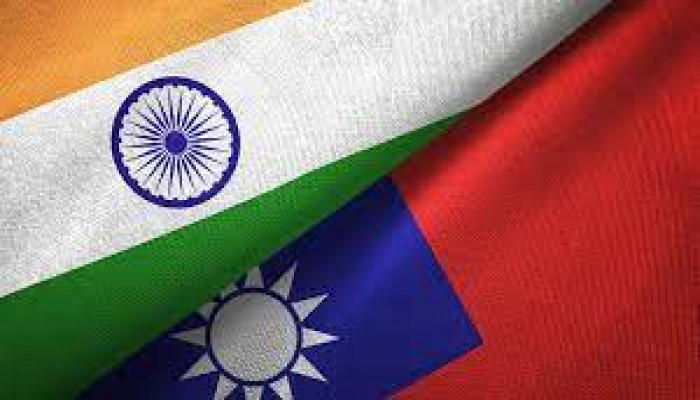Building a India-Taiwan Strategic Cooperation Framework
- In Foreign Policy
- 03:41 PM, Aug 31, 2022
- LT GEN P R SHANKAR (Retd)
India and Taiwan must establish an informally formal Strategic Cooperative system that is all-encompassing. The starting point of such a system is that both countries are democracies and these values have to be spearheaded and reinforced through political contact and exchange.
China has multiple territorial and maritime disputes with many nations. However, its most important disputes at this point in time are with Taiwan and India. The disputes with Taiwan and India are not merely territorial but hegemonistic and expansionist in nature. They are also part of China’s larger design to establish global supremacy and Sino-Centric world order. Annexation of Taiwan at the earliest is China’s first priority ambition.
PRC wants to illegally annex the island nation despite never having ruled it. Primarily Taiwan is the very antithesis of the Chinese propaganda that communism is the best form of governance or progress. Taiwan’s prowess in Chip manufacturing makes it an attractive economic and technological proposition to capture it. Capturing Taiwan also means defeating the USA and showing the latter’s inability to withstand Chinese military might.
Defeating the USA makes China a true superpower. Also, the fall of Taiwan breaks the first island chain irrevocably. This will enable unhindered global deployment of PLAN. It also prevents direct military contact with mainland China. In that eventuality, China becomes unassailable to transfer itself from being a nation consigned to defending itself to an outbound nation that can dominate the seas. In this context, Taiwan should never be allowed to fall unless the world is prepared for a Sino-Centric global order.
Defeating India in a military conflict is China’s alternate priority. Chinese apprehend that India is emerging as the global alternative to China if it is allowed to grow unimpeded. Hence it must hand India a military defeat and show it as incapable and weak. Additionally, even a small military victory over India enables enhancing PRCs influence in South Asia and promotes its unhindered entry into the IOR. Last but not the least, it will enable the expansion of Chinese control, south of the Himalayan crest line. This will lead to the eventual outflanking of the Pacific from the west and solving the Malacca dilemma.
Hitherto fore, China has been dealing with Taiwan and India separately. It has created conditions such that both these kindred democracies do not jointly form a united front. The fact that many countries including India don’t formally recognize Taiwan is a political hindrance to forming a united front against China. Also, the physical distance separating India and Taiwan has been an inhibitor.
However, in contemporary global conditions of enhanced electronic and digital connectivity, faster means of transportation, and increased feasibility of people-to-people contact, separation between Taiwan and India can be bridged to enable a joint strategic push against China. India and Taiwan must find new ways to enhance political, diplomatic, economic, cultural and military linkages which must go beyond mere cooperation. Most importantly, Taiwan and India must target the moves and weaknesses of the PRC jointly.
India and Taiwan must establish an informally formal Strategic Cooperative system that is all-encompassing. The starting point of such a system is that both countries are democracies and these values have to be spearheaded and reinforced through political contact and exchange. In an electronic world, the emphasis must be on digital rather than physical contact. Hence mechanisms must be explored to reinforce political support and views at multiple levels. India must enable Taiwan to expand and enter international political platforms even if it is through the back door at present.
It is in India’s and global interest that annexing Taiwan either militarily or politically becomes a goal too far for China. At the outset, political exchanges between India and Taiwan must be increased so that the latter is not politically isolated. That is what the USA has done with the visit of its speaker and congressional delegation recently. Visits by Indian politicians and parliamentary exchanges must be more visible. While we have already taken a few steps in this direction, the frequency has to be more.
As Chinese offensive military capabilities increase, so must Taiwan increase its defensive capabilities in proportion. This can be achieved by two methods. Firstly, Taiwan must be militarily strengthened to make it into a porcupine, similar to what Ukraine has become for Russia. A joint intelligence collection and sharing system will be the initial step in this direction. India with its huge military training and other capabilities can contribute much to Taiwan’s defence preparation directly. A military-to-military cooperation must commence. The indirect method will also be effective. In an era of multi-domain operations, any action by China against India or Taiwan individually should trigger a joint and reciprocal response in different domains.
In essence, China should constantly be faced with a multiple-front situation in multiple domains. In the current environment, the USA, Japan, South Korea, Philippines and Vietnam will be valuable international partners. The QUAD platform should be actively used to strengthen Taiwan. If China expects an Asian NATO from QUAD, it should be given to them.
India also has the capability to provide strategic depth to Taiwan and it need not be only military in nature. It will involve an increase of economy, science, technology, commerce and education cooperation and exchange programs. All these exchanges should also result in weakening Chinese economic influence globally. Hence exchanges in as many domains as possible will be valuable to both nations. The nuclear domain also needs to be exploited. There is a lot of scope for India-Taiwan nuclear cooperation. This should be on the same lines and principles as China-Pakistan or China-North Korea nuclear and missile cooperation was developed.
It is well known that China has five instabilities. Taiwan, Tibet and Xinjiang are its major instabilities. Hong Kong and Inner Mongolia remain its other instabilities. It is time that Taiwan and Tibet are conflated. Major information, human rights and lawfare campaign need to be commenced. The ‘One China’ policy must also be contended and dropped from the international lexicon progressively. As has already been done, strategic ambiguity regarding One China which has commenced must be persisted with. Taiwan must be enabled to incrementally achieve recognition as an independent state. Simultaneously, the autonomy/independence of Tibet should be progressed.
The human rights situation in Xinjiang and the concentration camps established by China need greater focus. All these issues should force China to look inwards. India can do a lot in this regard. It is also now established that China is weakening economically. Its weakness especially in the finance and real estate sector is causing unrest amongst the people. This also needs to be clubbed with the other Human Rights issues and taken up through all available fora. It is also high time that efforts are made to break the electronic firewall which China has built. If Taiwan and India join hands, a lot can be achieved.
It is also understood that in the absence of formal diplomatic relations between Taiwan there will be certain difficulties. However, that should not deter India or Taiwan. Both countries should learn to play in the gray zone. The approach should be to expand people-to-people contact through academic and cultural exchanges and then steadily widen the cooperation portfolio. It is also not necessary that all activities be visible in the public domain. A lot can be achieved in virtual domains and behind the scenes. New ways must be found to enhance political, economic, diplomatic, and military cooperation with Taiwan to tackle a common threat. There should be no doubt that China is a common threat.
Image source: Tribune India







Comments